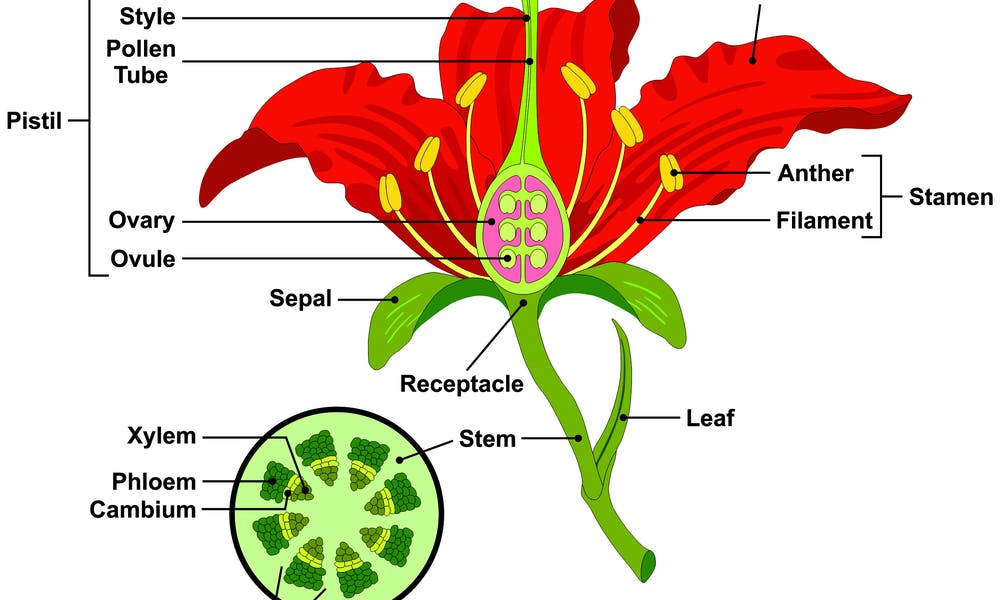MENU
Anatomy of a Flower

Many of us can recognize the necessary parts of a flower. For example, the stem and the petals are easily identifiable. Flowers are actually very intricate structures that are integral to the plants’ ability to reproduce. Reproduction is what leads to flowers, seeds, and fruits. It is an essential function of a plant and is important to understand, so we know where flowers and edible parts of a plant come from.
Depending on the type of plant, flowers have male parts or female parts. When the pollen grains, which come from male cells, pollinate the female cells, the plant is able to go to seed and create a plant’s offspring. Pollination takes place through several methods. Most well-known is through bees collecting pollen from one plant then moving on to another plant. Other insects are also able to pollinate, though not quite as effectively. For example, some wasps are pollinators, as are some types of flies. Pollination can also happen through the wind, and in more recent history by humans.
Interestingly, some plants actually have both male and female parts, which allows the plant to reproduce with itself. In order to understand how a plant reproduces, it is important to understand the basic anatomy of a flower. So, in this article, we discuss the different parts of a flower.
In this post, we are going to cover:
Functions of a Flower
For the plant itself, flowers function to allow the plant to reproduce. The reproduction of a flower creates new plants, seeds, and fruits. In addition, flowers are the plants’ way to attract insects for pollination.
Petals
The petals of a flower can be thought of as the housing for the internal parts. It is believed that flowers with brightly colored petals are pollinated by insects. The vibrant colors are the plant’s way of attracting its pollinator in order to reproduce. It is also thought that plants with dull green or even brown colored flower petals are pollinated through the wind. Petals on a flower are often distinctive in terms of shape, size, and margin and can be used to identify plant varieties.
Anthers, Filaments, and Stamen
This is the part of the flower where pollen is produced. Anthers are connected to a filament that connects them to the flower itself. Together they are called the stamen. One of the best examples for this is an Oriental Lily. These lilies tend to have anthers that are readily identifiable due to the open nature of the lily flower. The anther is round and yellow-orange in color, and if you touch it, the anther leaves orange markings on your hands and clothes. On insect-pollinated plants, the stamen is inside the flower. It tends to be stiff to allow insects to fly up against it to pick up pollen. For wind-pollinated plants, the stamen is on the outside of the flower and quite loose. This allows the pollen grains to drop off and be carried by the wind.
Stigma
The stigma is part of the female portion of a flower. The stigma is where pollen grains are collected in order to begin the process of pollination. The stigma is attached to the style, which is the stalk that attaches to the flower itself. The method is basically a tube pollen uses to travel through the flower. The stigma is located inside the flower and is sticky in nature. Because it is sticky when insects buzz by the pollen grains are transferred from the insect to the stigma. This is slightly different for flowers that are pollinated by wind. These types of flowers have a stigma on the outside. This allows pollen floating in the wind to catch on to the flower.
Ovary
The ovary is inside the base of a flower. This is where the fertilization of a plant takes place. When the correct type of pollen grain reaches the correct kind of stigma, pollination can take place. The pollen grain grows inside the style and meets an ovule, which is inside the ovary. This meeting of the male part, the pollen grain, and the female part, the ovule, is a plant’s version of fertilization. From here, the ovule can grow into the seed while the ovary develops into the rest of the fruit.
Nectary
The nectary in a flower produces and stores nectar. Nectar is a sugary substance used by the plant to help attract insects. The nectary is usually located near the base of a flower in order to help draw in insects deep inside. These flowers also tend to be scented, which is another useful function for attracting pollinating insects. Plants pollinated by wind tend not to produce nectar or scent. They do not need this function because there is no need to attract insects to their flowers.
Sepal
Sepals form a protective layer around an unopened flower. Usually green in color, sepals are the leaves that surround the area that is commonly referred to as the bud. They are highly useful in function because they help the keep the unopened flower from drying out. Sepals form at the top of a stem and are the first sign that a plant is going to produce flowers.
The flowers of a plant are multi-purpose and so important to humans, insects, and animals. As humans, we regularly benefit from the functions of flowers when we consume fruits and seeds. We also benefit from flowers by way of floral bouquets, essential oils, and perfumes. Animals and insects reap the rewards of flowers as a food resource and sometimes as their habitat.
It is clear that flowers are not quite as simple as they may seem. We tend to take plants and flowers for granted, passing by them without a second thought. Next time you are shopping for groceries, take a moment to understand and appreciate where the apples in your cart came from and what role flowers play in creating our food supply.

